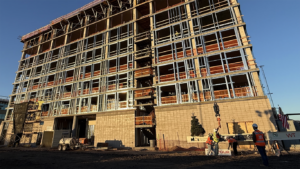Driven by strong population growth, Phoenix registered the highest net absorption of medical office space among all U.S. metros between Q2 2017 and Q2 2018, according to a new report from CBRE.
This positive net absorption resulted in an improvement to Phoenix’s medical office vacancy rate, which ticked down 260 basis points to 14.7 percent, the largest vacancy rate decrease among all markets. More than half of the markets in the report recorded increased vacancy over the same period.
“Phoenix will continue with strong medical office demand to match the growing population,” said Kate Morris, with CBRE’s Healthcare Services Group in Phoenix. “Phoenix has several hospital systems constructing new hospitals, micro-hospitals or expanding their current hospitals. This has, in turn, led to new medical office buildings being constructed or contemplated. However, it’s important to note that new product, coupled with the trend of repurposing retail to medical office space, will continue to pull tenants from older, less attractive medical office space that will eventually need to be repurposed.”
National Trends
The U.S. outpatient care center sector has grown robustly in recent years as asking rents for medical office buildings continue to rise and health systems seek to provide a better patient experience at a lower cost.
The U.S. average asking rent reached its highest level on record in Q2 2018, rising 1.4 percent year-over-year to $22.90 per sq. ft., due to tight market conditions and the completion of new, high-quality space. Phoenix’s rent growth outpaced the U.S. average, rising 4.3 percent year-over-year to $24.30.
“Rents increased in two-thirds of the markets tracked by CBRE and grew fastest in some of the markets with the lowest vacancy rates, including Louisville, Seattle, Nashville, Manhattan and Indianapolis,” said Andrea Cross, Americas head of office research, CBRE.
In addition to rising rents, health systems have increasingly turned to lower-cost outpatient centers—which enable them to provide lower-cost services closer to where patients live—due to higher capital costs stemming from mergers and acquisitions and a surge in in employer-sponsored, high-deductible health plans requiring patients to pay larger out-of-pocket amounts.
The total number of outpatient centers grew more than 50 percent to approximately 41,000 from 2005 to 2016. Outpatient center employment has more than doubled since 2003, and grew 3.5 percent year-over-year in October 2018, compared with 2 percent annual growth in overall healthcare employment.
“Healthcare systems are increasingly catering to patients as consumers—rather than simply users—of healthcare services,” said Mark Lamp, executive managing director, Healthcare, CBRE. “They are creating outpatient facilities that provide a more ‘hotel-like’ experience—and at a lower cost than the more expensive hospital services—with technology-enabled check-in, abundant natural light and incorporated outdoor spaces, and patient care concierges trained to support guests with any needs.”
Development Trends
Medical office development strongly correlates with population growth, with Phoenix, Houston, Dallas/Ft. Worth and Atlanta among the top markets for total completions from Q3 2017 to Q2 2018, along with Minneapolis/St. Paul, a leading healthcare cluster. Houston, Minneapolis/St. Paul, Atlanta, Chicago, the Inland Empire, Kansas City and Boston rank among the top markets for square footage under construction. Phoenix saw 521,427 sq. ft. of medical office construction deliveries between Q3 2017 and Q2 2018 and 1.34 million sq. ft. between 2010 and Q2 2018. The market had 22,350 sq. ft. of medical space under construction as of Q2 2018.
Capital Markets Trends
Trailing 12-month transaction volume decreased to just below $12 billion in Q2 2018 but remained not far off the cyclical high of $14.2 billion.
“Medical office properties have shifted from a specialty asset class to a core asset class,” said Chris Bodnar, vice chairman, Healthcare Capital Markets, CBRE. “Institutional and cross-border investors have ramped up their medical office acquisition activity, with cross-border investors on pace to record their highest annual level of net acquisitions in at least a decade in 2018.”



